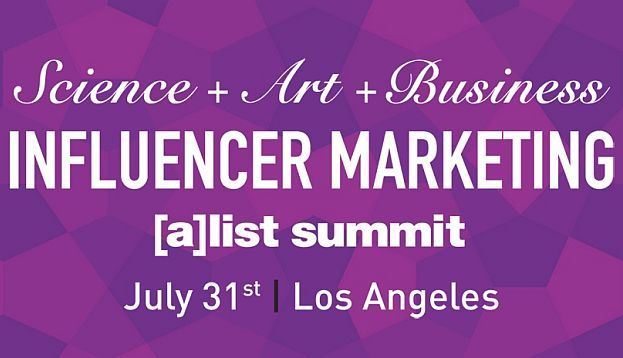The [a]list summit on Influencer Marketing took place last week on July 31st, and there were many industry visionaries as part of the proceedings — and in the audience. Here’s a summary of what went on during the event.
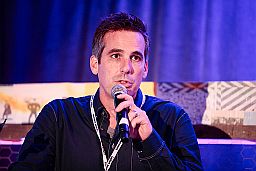 Chris Younger, principal and director of strategy, Ayzenberg
Chris Younger, principal and director of strategy, Ayzenberg
Welcome by Chris Younger
The summit was kicked off by Ayzenberg principal and director of strategy Chris Younger.”The three biggest topics we hear about from the [a]list daily are social, mobile, and influencers,”said Younger. The [a]list summit today will focus on influencers, a huge part of the changes that are transforming industries and marketing. “The rapid pace and change the industry is going through takes us on a journey where we may be pioneers in a new age of creativity,” Younger noted.
Setting the Stage
Julian Hollingshead, VP, strategy and client services
“We need to look at a snapshot of influencer marketing overall,” said Hollingshead. He discussed a range of influencers, from a brewer with thousands of followers to Beyonce.
Hollingshead mentioned various axes to think about with influencer marketing, like the find vs. buy continuum and the creation continuum. Influencers have many important roles. “They influence, they create, they are part of like-minded communities,” he said.
“What community leader wouldn’t want the brands they already love to reach out to them with information and content to talk about and share. If you can find these people and activate them, what a powerful force,” said Hollingshead.
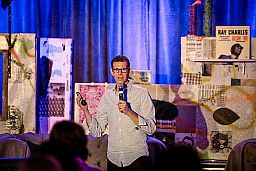 Eric Solomon, head of brand strategy. Google
Eric Solomon, head of brand strategy. Google
Keynote: Hypertelling
Eric Solomon, head of brand strategy, Google/YouTube
YouTube: 6 billion hours per month are viewed, 1 billion unique visitors, 20 percent of all Internet traffic.
“We’ve been in the middle of a digital revolution for a long time,” said Solomon. Advertising is now about orchestration, not just integration. How does all this crap go together?” asked Solomon. “It really is an orchestration of all these things.”
“The idea of content these days is very liquid,” Solomon noted. “There’s no space limitation on YouTube.” This gives you complete freedom to craft messages the way you want.
“The user is in control,” Solomon noted. Consumers are very demanding, and they want content “where I want it, when I want it, how I want it.” “We’re very demanding as consumers,” said Solomon. “This makes the difficulty of how all this goes together very, very complicated. If it was passive before, consuming content is a very active thing. It’s about providing something that’s relevant, compelling, contextual content, not just advertising.”
“It’s not just telling a story if you’re a brand, it’s what happens to it after you tell it,” said Solomon. As his mom noted, it’s about hyperlinks… which led him to the word Hypertelling. Speaking about Nike’s masterful Olympics campaign, Solomon said: “It was about not just integration of content, but orchestration.” He drove it home with his summation: ” It’s no longer about where it can go, but where it should go. How much is up to the brand, and how much is up to the user You don’t own it any more, people are going to want to do something with it if it’s good.”
Ultimately, Solomon noted, “Can we give people a reason to believe ”
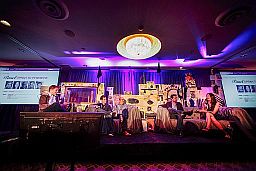 Oprah to PewDiePie panel
Oprah to PewDiePie panel
Oprah to PewDiePie
Moderator, Jim Louderback, GM Digital Discovery Network
Jeanette Liang, executive director of global digital marketing at ADF, Estee Lauder Companies; Phil Ranta, VP of talent operations at Fullscreen & PronunciationManual; Jack Vale, Fullscreen and Rob Ciampa, CMO of Pixability
PewDiePie had 350 million views in June, his audience 75 percent male. “From a brand perspective, he’s not an influencer,” said Ciampa. Liang said “he has the potental to be an influencer, but it’s up to the brand to work with him to make him an influencer.” Ranta believes he is an influencer, he just doesn’t know he is, as the Flappy Bird example illustrates.
“What makes a good influencer?”asked Louderback. “Who are you speaking to?” responded Liang. “It comes down to how receptive they are and how smart they are. If you have seven status meetings with them and you can’t get it through to what you want them to do, that’s not good.”
“You have to find something you think your audience is going to be receptive to,”said Vale.
“We have a view obsession,” said Ciampa. “We’ve looked at influencers and they are really good at engagement. Many brands can’t have that because they have some intern doing engagement.”
“There are companies that are looking for up-and-comers,” said Liang. They are always trying to find the people who are in the process of building an audience. “We’ve got a team who’s out there finding and signing,” said Ranta, using a team of people who are savvy and immersed in the market.
Ranta noted they’ve just started partnering with Vine channels. They are starting to combine the Vine and YouTube worlds, to help popular Viners get paid.
How do you balance what you want to do with what the brand wants to do?” asked Louderback. “Like I do my marriage,” said Vale. “It’s all about give and take.”
Liang noted that they have an objective, but not a list of tactics. Those are developed with the influencer. “We let the conversation be a very genuine brainstorm,” Liang said. Ranta agreed. “I feel the best interactions are collaborations.”
“When you do things right, organic happens,” said Ciampa. He mentioned a campaign they just did for Puma, and it got great organic traffic and engagement. “True success is organic.” Vale agreed, saying that buying views just really doesn’t work ultimately.
“Is traditional advertising going to disappear and be replaced by influencer marketing?” asked Louderback. “The digital audience expects a different experience,” said Ciampa. “We’ll always have TV advertisements,” said Liang. Ranta had difficulty thinking of any form of advertising that ever died. “As long as there’s still an end user that’s absorbing something in a meaningful way, there will still be advertising,” said Ranta.
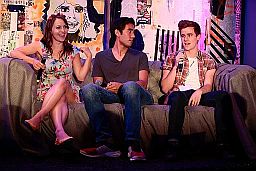 Creator Visionaries panel
Creator Visionaries panel
Creator Visionaries
Moderated by [ion] talent group director Brian Foster
Olga Kay, filmmaker and founder of Mooshwalks; Zach King, filmmaker, and Connor Franta, filmmaker.
Starting off with videos from all three of the creators, they talked about the experiences. Franta worked with Coke on a series of videos, and let them shoot him and do the editing — which he’d never done before. King did some great stunts on Vine, and because of that was bale to partner with brands. So many brands are sticking with what’s new and hot, like SnapChat and Vine. Kay talked about hwo she came from traditional media as an actress seven years ago, and now she’s teaming with brands as a creator and it’s a very different experience. Now she has her own brand and is creating content for her own brand.
“How do you create all of that content by yourself?” Foster asked. “I started because it was so difficult to break through and do the things you wanted to do,” Kay said. “Now nobody is telling us what not to do. It’s so hard to let people come in and take over.” Fanta noted. “I find it easy to work with brands I like.” King agreed, noting that all three of them “are very picky about the brands they works with. I think that as a brand, you want to partner with influencers who are picky.”
The panelists noted that it’s not just all about YouTube, and it’s important to work with other media as well. “The most powerful platform right now is Instagram,: said Kay. “Whenever a brand approaches me I check to see if they have an Instagram account.”
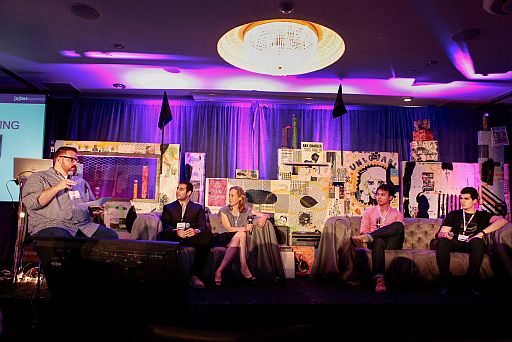 Harmonizing panel
Harmonizing panel
Harmonizing
Moderated by Noah Eichen, director of original content for Ayzenberg Group
Justin Rezvani, founder and CEO of theAmplify (Instagram Network); Larke Paul, senior director, creator program and partnerships, Defy Media; and Kong P, co-founder and CEO of Simple Pickup. Christian DelGrosso, filmmaker on Vine.
“Authenticity is the big thing,” said Rezvani. He noted that the content has to be believable to have an impact. “Content is the big thing,” said Paul. “Our time is very valuable, and the things that really speak to us can reach millions around the world.” Kong talked about some of the problems he’s encountered. “The biggest hurdle is to get the brand to understand that this is my content,”Kong said. “Their ideas might work if they do them somewhere else, but I have to do what my audience will like.”
“What can you do to make sure that content stays organic to your audience?” asked Eichen. “We brainstorm ideas that we would do anyway if the brand wasn’t there,” said Kong. “We use technology,” said Rezvani. “We use our technology to find out who are the perfect influencers, and use technology to help them create the content, and then to find the right audience. It’s not just who you are as influencers, but who are you reaching.”
“We’ve done some really cool things with an email list,” said Kong. “The more platforms you are on, the better your reach.” “Do brands have ideas on what to do with each platform?” asked Eichen. “They always come with the biggest platform in mind,” said Kong. “We have to put amazing content on every platform,” said Paul. “It’s challenging, but creatively rewarding.” “We haven’t gone to other platforms because they don’t give us the data,” said Rezvani. “Fortunately Instagram has a wonderful API and we can get that data. What matters is the number of viewable impressions you get on Instagram. We’ve chosen to go to platforms where we can get that data.”
“How important is analytics?” asked Eichen. “It’s the most important thing,” said Rezvani. “That data is what’s driving why companies want to work with us and work with talent in a larger way.” “Data is absolutely important,” agreed Paul. “What’s my ROI? There’s also a qualitative angle, as in how a piece of content has changed attitudes towards a brand.”
“What is the most important metric for measuring success?” asked Eichen. “It depends on the goal of the campaign,” said Rezvani. They used a third-party analysis metric on a recent campaign for a movie, and found a 27 percent increase in purchase intent for tickets. That’s a really useful metric to give to a brand looking to judge how a campaign is doing.
We love the ability to dive a little deeper and see if this made an impact on somebody,” said Paul. “It’s a little harder to get that, but we like to do it.”
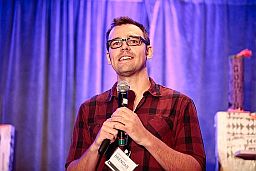 Brendan Gahan, YouTube marketing expert
Brendan Gahan, YouTube marketing expert
Blowing the F#@k Up
Brendan Gahan, YouTube marketing expert
In 2008, we worked on a campaign for the launch of Spore. We sold through a campaign where we were going to get 50 celebrities to create creatures and post them all on a web site. Katy Perry, Mark Cuban, Elijah Wood, and influencers on the social side like iJustine. Phil DeFranco got 100+ votes in 24 hours. At the very bottom were traditional celebrities like Katy Perry. We all know these celebrities, but their recognition doesn’t necessarily translate to impact.
We’re at a stage in this space where there’s so much hype, focused on the top one percent of creators. It’s very cool, but supply and demand will dictate their prices are going up. There’s a big opportunity to stop and say, why am I working with these people It’s important to recognize there are 50,000 creators out there with over 10,000 followers. Buy low and sell high.
“Make it their idea,” Gahan urged. He noted how important it is to work with influencers rather than handing them a script. “Imagine if you’re going out with a friend of yours and they just jump into a sales pitch to you,” Gahan said. “It would feel really weird. That’s what it feels like when you’re writing words for these people. Don’t armchair art direct. You want to hit that sweet spot where everybody wins – brand, influencer, fans.”
Gahan also reminded the crowd that “You are not your audience. The content does not necessarily need to look the same way. Put yourself in the shoes of the creators.”
The sheer flood of content out there makes it difficult to have an impact. “500 million tweets each day. 100 hours of video posted to YouTube every minute. It’s extremely hard to have an impact,” Gahan said. “So what’s the solution You want to start the snowball effect. Focus your efforts so everyone stops and looks at what you’re pointing to. Working on the promotion for Rise of the Planet of the Apes, worked with 50 YouTubers who were influential. We flew them to LA and introdcued them to all the creators. We gave videos a week in advance to key influencers and had them prep content, and their seven videos got an aggregate of 70 million views.”
Key takeaways:
Bigger is not always better. Why am I selecting these people Let your competitors work with people and overpay for the same audience. Make it their idea. What can you do so influencers will get excited? Create a moment in time. The impact will be greater if you schedule it properly. And finally, YouTube us a decade old. Prepare for what’s next.
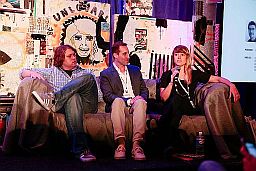 Discovery panel
Discovery panel
Discovery
Moderator Vincent Juarez, principal and media director at Ayzenberg
Andrew Barrett, director of marketing for Jukin Media; Allison Stern, co-founder and GM of media solutions at Tubular; Matt Gielen, director of programming & audience development at Frederator Studios; Mary Healey, global lead, YouTube Brand Partner program; and Tony Chen, CEO, Channel Factory.
“As marketers, we have a problem. There’s so much content vying for our attention, how do we get people’s attention ” asked Juarez.
“We try to make something great our users will want to watch,” said Healey. “It can be inspirational, like P&G’s Moms channel. Or “How to tile a bathroom floor,’ which has over two million views. That’s a safe and antural place for brands to get started.”
“We are the company finding the content,” said Barrett. “We’ve only in the last year started working with brands. It’s very enticing for brands because they can get 100 percent of voice, but we have to proceed very carefully.”
“We think about the audience, not necessarily about the brand,” said Gielen.
“Partner with native YouTuve influencers,” said Stern. “If you partner with someone who’s taken years to build their audience, that’s absolutely the right answer.” She also noted how important it is to see what’s already out there.
“You have to create content that’s current,” said Chen. “Buy content and contextual media to really get your content out there, to the right people and the right places.”
“Who do you think is providing best-in-class discovery of content?” asked Juarez.
“Rise of the Planet of the Apes,” said Chen. “The content creation part of it was spectacular, and the distribution side of it really created an impact.”
“Discoverability can mean many things, but platform is important,” said Stern. “Vine is doing a really good job of this. On YouTube, tentpole events is doing a really good job with this concept, tying in with things people are already searching for.”
“People won’t click on something until they’ve seen it ten times in their feed,” said Gielen. “You can’t overlook the power of many individuals in generating interest.”
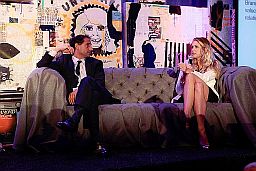 Media-Ization panel
Media-Ization panel
Media-Ization
Moderated by Ayzenberg principal and director of strategy Chris Younger
Jonah Minton, senior vice president, sales and brand strategy, Fullscreen; and Scott Carlis, VP, digital and social media, AEG global partnerships.
“One percent of the marketing budget is going into influencers,” Younger pointed out. “Yet all of you guys are here today. What is going on here CBS had 35 million unique viewers last month. How do you classify influencers in your marketing mix? Where does the budget come from? Typically when you add in one area you take from another?”
“There’s not one central location for influencer marketing,” Minton noted. “We have to talk to everybody and connect the dots for different opportunities. Budget is coming from everywhere. A lot of the market is really getting excited about influencer marketing, because we see how many millions of viewers they have but we aren’t familiar with them. Can you describe them? We call them the connected generation, who seek out digital sources of entertainment. If you’re 15 or 16 you might not be going to Comedy Central, you might be going to Shane Dawson’s channel. We see the influencer landscape as the next evolution of the TV landscape.”
“We’ve been working with influencers at SOE for over two years, and we’ve learned a lot,” said Naviaux. “Influencers run the gamut, from influencers who are just getting started and want the attention from SOE, so we architected our web site to help them grow. Then you have influencers who have already made it, and we try to work with them, to.”
“We certainly are in a unique position, because we are in the most passionate areas of sports and music,” said Carliso. “One of the beauties of social and digital is that it becomes must more emotional. Now it’s how do we develop deeper connections, how do we get our influencers to share the best experience they’ve ever had.”
“When you’re a brand, you’re an influencer — when you’re an influencer, you’re a brand,” said Minton, noting that it’s time to move away from thinking about campaigns. It’s more of a continuous effort that’s required. “We want to do campaigns, it’s important to drive revenue for a particular quarter, but you would never do just one tweet and walk away. Video content and influencer marketing are similar — you have to think about it constantly.”
“Early on in the lifecycle of Planetside 2, TotalBiscuit made a video and the next day there was three times the registrations,” said Naviaux. “We brought influencers down to SOE and measured the influences as their streams went up, and we saw a ten to twenty percent lift.”
“Knowing influencers are looking for exclusives, early access, product — where does it fit in the campaign strategy ” asked Younger.
“It’s worked phenomenally well,” said Naviaux. “Are you somebody that has a voice with our competitor? Are you credible? We’ll fly you down and let you play our game. It works, but it’s challenging. You want to make sure you’re taking care of the press. We think long and hard about the distribution strategy as well as the content we’re creating.”
“64 percent of influencers make revenue from blogging. Much has been said about brands paying influencers to endorse a product or service — is this wrong? Is it a form of journalism or press? ” Younger queried.
“As long as you’re up front about it, you’re fine,” said Naviaux.
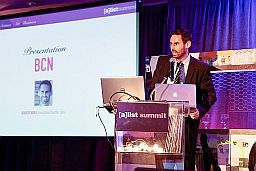 Robert Brill, executive director, [ion]
Robert Brill, executive director, [ion]
BCN — the Brand Channel Network
Robert Brill, the executive director of [ion]
We are launching the Brand Channel Network, something we’ve spent a long time developing.
Influencers, marketers and the Brand Channel Network connects them together, noted Brill. “People are spending time away from television, and this is a big opportunity for brands and marketers.” He talked about the differences between Big TV vs. Big Tech, and Traditional vs. Digital, “a massive reogranization of the traditional TV market” that’s happening right now, Brill pointed out.
Brill discussed the 116 million Nielsen homes in the U.S. served by Big TV. Big Technology is all the publicly traded companies that go over the Internet (over-the-top delivery of television, in the common parlance). Brill noted that a recent report from Luma Partners that while Big TV seems impressive, it’s dwarfed by Big Tech. The digital market cap of Big Tech is $1.6 trillion versus a $400 billion market cap for Big TV, and Big Tech has 5x more cash on hand. “Big Tech has plenty of money to buy, support and pay for structures to compete with TV,” Brill pointed out. “Big TV has 500 channels, Big Tech has over 1 million channels. This year users spend more time with digital than TV, for the first time (via eMarketer).”
Marketers are left with significantly fragmented audiences, Brill proclaimed. According to comScore Online Video Rankings, “153 million unique users watch content on YouTube monthly, and another 91 million watch content of Facebook monthly.” So while the audiences are fragmented, social networks provide easy distribution, low cost production equipment, and more demand for content means far more content becoming available.
Ultimately, Brill said that BCN is going to be a key player in bridging these gaps. “BCN will enable scalable co-creation of content. Influencers, and marketers will become another competitor to television.”
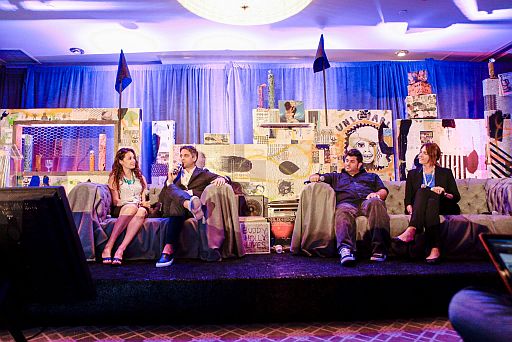 Online Video Leadership panel
Online Video Leadership panel
Online Video Leadership
Jocelyn Johnson, founder of VideoInk
Angie Barrick, head of industry, media and entertainment for Google/YouTube; Paul Kontonis, SVP, strategy and sales, CDS, executive director, GOVA; Nathan Brown, general manger, video, Complex Media; and Shira Lazar, What’s Trending.
“Is some of this content purely entertainment or is it propaganda?” asked Johnson. We try to remind people that three of the top ten videos on YouTube were created by brands,” said Barrick. “You see brands being successful when they create content that does not require the brand to exist,” said Kontonis. “Entertainment works really well on YouTube, you have to lead with entertainment.” “A lot of it is propaganda, you have to be very careful,” said Brown. “But a lot of the viewers are 18 year olds who just don’t care as long as it’s good.”
“How much should you be putting toward paid to get your video started?” asked Johnson. “We encourage our advertisers to create great content and give it a push to get started,” said Barrick. “What you can’t do is use paid and look at the view number out of that and saw ‘Wow, we’re successful!'” said Kontonis.
“Complex partnered with Pepsi to launch Grey Label, which is its own destination site. They produce, with the blessings of Mountain Dew, a lot of content every day,” said Brown. “We’ve had tremendous success with that, our traffic has actually eclipsed what Mount Dew does. We’ve actually begun to sell ads to non-competitive brands on the site and used that revenue to generate more content.”
“How do you really hone in on a niche? What about eSports, or something like Minecraft?” asked Johnson. “The Complex model is built on niche communities,” said Brown. “We can go super deep and be super authentic in these niches, and these subcultures amount to what passes for pop culture these days.”
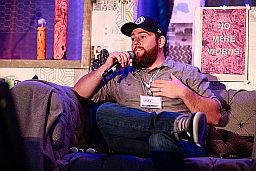 Shay Carl, co-founder, Maker Studios
Shay Carl, co-founder, Maker Studios
Closing Keynote: Shay Carl, the co-founding talent of Maker Studios and filmmaker, Shay Carl and the Shaytards.
Shay’s keynote was a series of observations drawn from his experience as a creator and working with many other creators in the process of building Maker Studios. Some of the highlights:
“You made it to the end of the day… remember, authentic, organic, content. Just don’t lie.”
“They’re going to stop putting a premium on the size of the screen, and realize that eyeballs are all the same size.”
“I’ve made daily videos every day for five years.”
“When I watch YouTubers, it motivates me to make my videos.”
“My favorite part of what I do is the two hours from 10:30 to 12:30 when I’m stalking my friends on YouTube.”
“I spend about an hour after my video goes live, linking and posting.”
“Sometimes advertising is the best content. I watch the Super Bowl for the commercials.”
“It’s good if you’re here in this room, it shows you’re ahead of the curve.”
